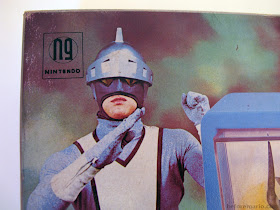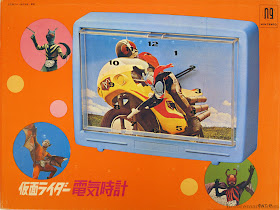Toy manufacturers capitalized on this phenomenon and produced boatloads of games and other items with super hero imagery. Nintendo also acquired licenses to use the protagonists of a number of these television series and used these for things like board games, playing cards and N&B Block construction sets.
In 1971 Nintendo extended their product line with a series of super hero themed electric clocks, called E-clock. The Japanese name was simply Nintendo Electric Clock (任天堂 電気時計).
 |
| Nintendo electric clocks from 1971 |
1971 is an interesting year in the history of Nintendo. In this year Nintendo also released the Light Telephone and the Copylas printing machine. But back to the clocks.
The clocks were sold in attractive, colorful boxes with a Styrofoam base and a cardboard top.
There are 4 different super hero clocks in this series: Mirror Man, Silver Kamen, Ultraman and Kamen Rider.
 |
| From top to bottom: Mirror Man, Silver Kamen, Ultraman and Kamen Rider |
The first clock we will zoom into is that of the Silver Kamen (シルバー仮面).
 |
| Nintendo Silver Kamen electric clock (1971) |
The box contains a "Nintendo" logo on the side and a "Nintendo Game" logo on the top.
 |
| Nintendo Game "NG" logo on the front of the box |
The clocks were atractively priced, at ¥1,800 each.
 |
| Original price tag still on the box |
The bottom of the Styrofoam box also contains a large embossed "Nintendo Game" logo.
 |
| "Nintendo Game" logo in the bottom of the box |
A power cord is attached to the clock. It runs on 100 volts.
 |
| Nintendo Silver Kamen electric clock |
The faceplate of the clock contains a scene from the Silver Kamen television series.
 |
| Instructions for changing the face plate |
Each clock came with two additional scenes, which could be replaced easily by opening the front of the clock and temporarily removing the hands
 |
| Fight! |
The clock does not have a standard seconds hand. Instead, the Silver Kamen figure in the middle spins around, its leg indicating the seconds.
 |
| Silver Kamen figure takes a minute to spin a full round |
Except for a copyright notice in the back, the clock does not contain a Nintendo logo, using the "E-clock" name instead.
 |
| The front shows the "E-clock" name |
The back of the clock reveals the housing of the clock mechanism.
 |
| Back of the clock |
The Nintendo copyright notice can be found on the back of the clock housing.
 |
| Nintendo copyright notice on back of the clock |
Observing readers may have noticed some clocks contain a "50Hz" label, while others are labelled "60Hz". This relates to the power frequency the clock is designed to work with.
Around the world, different types of power frequency are used. These days, 50 Hz is the most common. Japan, somewhat surprisingly, uses two different types of power frequency. The western part of the country (Kyoto and west) uses 60 Hz and the eastern part (Tokyo and east) uses 50 Hz. This originates in the first purchases of generators from German AEG in 1895, installed for Tokyo, and American General Electric in 1896, installed in Osaka. [Source: Wikipedia]
You had to buy the right clock type according to your geographical region. If you did not get the right power frequency type, it would run too fast or too slow - which is is not very convenient, for a clock.
 |
| The manual shows the 50 Hz and 60 Hz regions in Japan |
Next up is the Kamen Rider (仮面ライダー) clock.
 |
| Nintendo Kamen Rider electric clock (1971) |
The image on the faceplate shows the Kamen Rider on his bike.
Additional face plates allow the clock to be equipped with your favorite Kamen Rider figures.
 |
| One of the Kamen Rider clock face plates |
How about this blue lady insect villain?
Like the Silver Kamen clock, the seconds hand is replaced by a spinning Kamen Rider figure.
 |
| The Kamen Rider's leg indicates the seconds |
Clock number three features arguably the most popular of all these super heroes: the mighty Ultraman (ウルトラマン).
 |
| Nintendo Ultraman electric clock (1971) |
Unlike the other super heroes clocks, this one isn't blue but cream colored.
The last of the four clocks features Mirror Man (ミラーマン).
 |
| Nintendo Mirror Man electric clock (1971) |
This clock has some great face plates, showing a huge Mirror Man battling it out in a city under siege.
All in all a great series of super hero merchandise.
 |
| The four super hero clocks |
But wait. There is more.
Besides the four super hero clocks, there is a fifth one, with a more peaceful theme: Disney.
 |
| Nintendo Disney electric clock (1971) |
The clock is called "Disney Manga" (ディズニーマンガ), which of course means "Disney Cartoon".
The face plates feature scenes from Bambi, Snow White and Lady and the Tramp.
Over the years, Nintendo has produced quite some toys based on Disney characters. This started with playing cards in the early 60s and was followed by a lot of boardgames in the 60s and early 70s. In the 80s a number of great Game & Watch games featured Mickey Mouse and Donald Duck.
 |
| Nintendo copyright and Disney license on the back of the clock |
A spinning Tinkerbell indicates the seconds.
In 1972 Nintendo released a sixth clock, called Panda electric clock (パンダ電気時計). This one has two cute panda's on the faceplate.
Find out more about this final clock in the E-clock series in this post.
[Update 2024] And there's even more! A few years ago a seventh Nintendo clock from the early 1970s surfaced, called Love Peace electric clock, featuring the well-known Smiley design.
This bring the total number of known clock design to seven.
Check out all about this Smiley clock here.








































